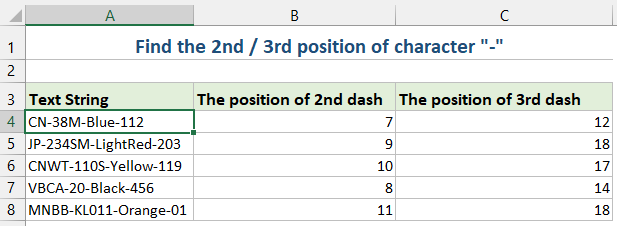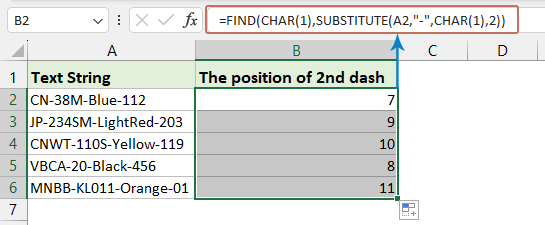Excel'de bir karakterin n. tekrarını bulma – 3 hızlı yöntem
Excel'de bir metin dizesi içinde belirli bir karakterin n. tekrarını bulmak, özellikle veri analizinde oldukça yararlı olabilir. Örneğin, dizeleri ayrıştırmak veya belirli sınırlayıcılar veya desenler temelinde bilgi çıkarmak isteyebilirsiniz. Örneğin, bir metin dizesinde "-" karakterinin 2. veya 3. tekrarını bulalım. Bu görevi etkili bir şekilde gerçekleştirmek için size basit teknikler göstereceğim.

Bir formül kullanarak bir metin dizesindeki bir karakterin n. tekrarını bulma
Bir karakterin n. tekrarını bulmak için bir formül oluşturabilirsiniz. Lütfen şu adımları izleyin:
1. Sonucu almak istediğiniz hücreye aşağıdaki formülü girin veya kopyalayın:
=FIND(CHAR(1),SUBSTITUTE(A2,"-",CHAR(1),2))- "A2": Metni içeren hücre.
- "-": Aradığınız karakter.
- "2": Bulmak istediğiniz 2. tekrar, ihtiyacınıza göre 3, 4… olarak değiştirebilirsiniz.
2. Ardından, formülü diğer hücrelere doldurmak için formül dolgu tutamağını aşağı çekin ve "-" karakterinin 2. konumu hemen görüntülenecektir, ekran görüntüsüne bakın:
- "SUBSTITUTE", karakterin n. tekrarını yazdırılamayan bir karakterle (CHAR(1)) değiştirir.
- "FIND", bu yazdırılamayan karakteri arar ve n. tekrarın konumunu verir.
Kutools for Excel ile bir metin dizesindeki bir karakterin n. tekrarını bulma
Eğer formül veya VBA kullanmaktan hoşlanmıyorsanız, Kutools for Excel'ı kullanmayı düşünebilirsiniz. Formül gruplarının içinde, herhangi bir hücredeki bir karakterin n. konumunu hızlıca belirleyip döndüren "Bir dizedeki karakterin N. tekrarlanma konumunu bul" adlı kullanışlı bir araç bulacaksınız.
Kutools for Excel'i yükledikten sonra, "Kutools" > "Formül Yardımcısı" > "Formül Yardımcısı" öğesine tıklayarak "Formül Yardımcısı" iletişim kutusunu açın. Sonucu koymak istediğiniz hücreye tıklayın. Ardından, şu adımları izleyin:
- "Formül Türü" bölümündeki açılır listeden "Arama" seçeneğini seçin;
- "Bir formül seçin" bölümünde "Bir dizedeki karakterin N. tekrarlanma konumunu bul" seçeneğini seçin;
- Kullandığınız dizeyi içeren hücreyi seçin, ardından "Argüman Girişi" bölümündeki metin kutularına belirtilen karakteri ve n. tekrarı yazın;
- Son olarak, sonucu almak için "Tamam" düğmesine tıklayın.

Kutools for Excel - Excel'i 300'den fazla temel araçla güçlendirin. Sürekli ücretsiz AI özelliklerinden yararlanın! Hemen Edinin
Kullanıcı Tanımlı Fonksiyon ile bir metin dizesindeki bir karakterin n. tekrarını bulma
Bu bölümde, Excel'de bir karakterin n. tekrarını bulmak için bir KTF'nin nasıl oluşturulacağını ve kullanılacağını adım adım açıklayacağız, böylece veri işleme becerilerinizi optimize etmenize yardımcı olacak bir rehber sunacağız.
- "ALT" + "F11" tuşlarına basılı tutun, bu da "Microsoft Visual Basic for Applications" penceresini açar.
- "Ekle" > "Modül" öğesine tıklayın ve aşağıdaki makroyu Modül Penceresine yapıştırın.
Function FindN(sFindWhat As String, _ sInputString As String, N As Integer) As Integer 'Updateby Extendoffice Dim J As Integer Application.Volatile FindN = 0 For J = 1 To N FindN = InStr(FindN + 1, sInputString, sFindWhat) If FindN = 0 Then Exit For Next End Function - Ardından, vba penceresini kapatın. Çalışma sayfasına geri dönün, aşağıdaki formülü bir hücreye girin ve ardından formül dolgu tutamağını aşağı çekerek formülü diğer hücrelere doldurun, ekran görüntüsüne bakın:
=FindN("-",A2,3)
- Bir sütundaki bir kelimenin kaç kez geçtiğini sayma
- Aşağıdaki ekran görüntüsünde gösterildiği gibi bazı yinelenen değerler içeren bir sütun veriniz varsa ve bu sütunda belirli bir kelimenin kaç kez geçtiğini saymak istiyorsanız, bu öğretici ile Excel'de bunu hızlıca çözmek için bazı ipuçları tanıtacağım.
- İlk n karakteri veya n. tekrarı başka bir karakterle değiştirme
- Excel'de genellikle Bir Bul ve Değiştir fonksiyonu ile bir dize bulup değiştiririz, ancak aşağıdaki durumlardan birindeyseniz, Bul ve Değiştir fonksiyonu size yardımcı olamaz.
- Bir dizeden n. karakteri çıkarma
- Genel olarak, belirli bir karakterden sonra metin çıkarmak isteyebilirsiniz, ancak bu durumda, aşağıdaki ekran görüntüsünde gösterildiği gibi bir dizeden n. karakteri çıkarmak istiyorum.
- Dizeden ilk/son n karakteri çıkarma
- Örneğin, her hücrede uzun dizeler içeren bir liste varsa ve her diziden yalnızca ilk n karakteri çıkarmak istiyorsunuz, örneğin her dizenin ilk 3 karakteri, şimdi bunu Excel'de çözmek için aşağıdaki yöntemleri kullanabilirsiniz.
İlgili Makaleler:
En İyi Ofis Verimlilik Araçları
Kutools for Excel ile Excel becerilerinizi güçlendirin ve benzersiz bir verimlilik deneyimi yaşayın. Kutools for Excel, üretkenliği artırmak ve zamandan tasarruf etmek için300'den fazla Gelişmiş Özellik sunuyor. İhtiyacınız olan özelliği almak için buraya tıklayın...
Office Tab, Ofis uygulamalarına sekmeli arayüz kazandırır ve işinizi çok daha kolaylaştırır.
- Word, Excel, PowerPoint'te sekmeli düzenleme ve okuma işlevini etkinleştirin.
- Yeni pencereler yerine aynı pencerede yeni sekmelerde birden fazla belge açıp oluşturun.
- Verimliliğinizi %50 artırır ve her gün yüzlerce mouse tıklaması azaltır!
Tüm Kutools eklentileri. Tek kurulum
Kutools for Office paketi, Excel, Word, Outlook & PowerPoint için eklentileri ve Office Tab Pro'yu bir araya getirir; Office uygulamalarında çalışan ekipler için ideal bir çözümdür.
- Hepsi bir arada paket — Excel, Word, Outlook & PowerPoint eklentileri + Office Tab Pro
- Tek kurulum, tek lisans — dakikalar içinde kurulun (MSI hazır)
- Birlikte daha verimli — Ofis uygulamalarında hızlı üretkenlik
- 30 günlük tam özellikli deneme — kayıt yok, kredi kartı yok
- En iyi değer — tek tek eklenti almak yerine tasarruf edin

